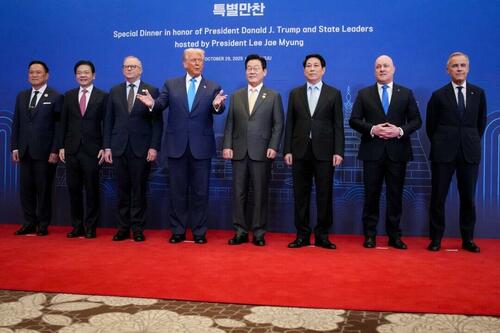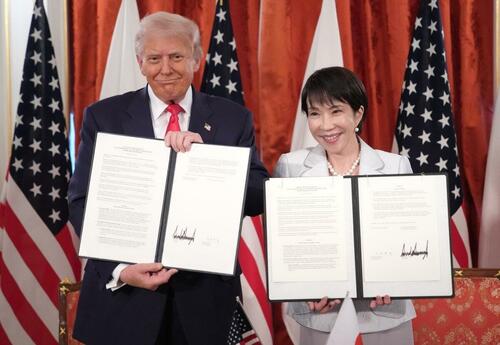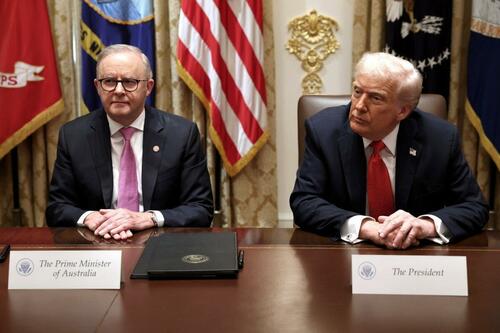Authored by Charles Davis via The Epoch Times,
The debate in Washington often treats allied policy toward China as a loyalty test—are you “with us” or “soft”? That’s the wrong frame.
Across the Indo-Pacific and beyond, close U.S. partners are converging on a pragmatic line: keep markets open where possible, harden national security where necessary, and build redundancy in supply chains so no single chokepoint—Beijing’s or anyone else’s—can hold the economy hostage. That logic aligns with the Reagan–Trump piece: deterrence through real channels, “plumbing” in supply chains, and coast-guard-first crisis management.
Canada: Warm Optics, Hard Guardrails
Beijing’s late-October global message framed the meeting between Chinese leader Xi Jinping and Canadian Prime Minister Mark Carney as a “turnaround,” invoking the “20th anniversary of the China–Canada strategic partnership” and saying both sides would “jointly advance” it.
Ottawa’s perspective was notably cooler, describing a pragmatic reset and workmanlike efforts to clear trade “irritants,” avoiding the “strategic partnership” language. The label itself is not new: Beijing has used it since the relationship was raised in 2005 under then-Prime Minister Paul Martin and then-Chinese leader Hu Jintao, and Chinese statements this fall repeated that phrasing even as Ottawa sidestepped it. The nuance matters because markets and allies read signals carefully.
Beneath the rhetoric, the policy architecture points in one direction: tighter security and selective economic reopening. Canada’s May 2022 decision barred Huawei and ZTE from 5G networks and set removal deadlines—June 28, 2024, for 5G gear and end-2027 for legacy 4G—while pushing operators to halt procurement as of September 2022. It tightened controls on the essentials without triggering a full break.
Parliament also enacted the Countering Foreign Interference Act in June 2024. This measure created a Foreign Influence Transparency and Accountability regime and strengthened authorities across the Canadian Security Intelligence Service (CSIS) and the Criminal Code. Read it alongside departmental briefing books, and you see a through-line: Ottawa is expanding legal and administrative tools even as it tests a trade thaw. The result is a diplomatic reset tailored with harder domestic guardrails.
That reading also answers a recent op-ed claim that Ottawa “declared” a strategic relationship amid hybrid threats. Beijing certainly emphasized the term. Ottawa did not. When we anchor to primary records—government documents and statements, as well as the statutes and telecom directives—the story is not capitulation but compartmentalization: warmer tone for markets and consular problem-solving, as well as firmer lines around critical tech and interference. That is the same pattern we see in Japan, Australia, and the Philippines.
Japan: Rearming Carefully, Walling Off the Crown-Jewel Tech
Tokyo’s 2022 National Security Strategy marked a generational shift: lift defense spending toward 2 percent of GDP by fiscal year 2027 and acquire counter-strike capacity, including Tomahawk land-attack missiles. Contracts signed in January 2024 locked in hundreds of Tomahawks to accelerate that capability, with public justifications tied to Chinese and North Korean missile trends. The politics are sensitive; the trajectory is clear.
President Donald Trump and Japanese Prime Minister Sanae Takaichi hold up signed documents for a critical minerals/rare-earth deal with Japan during a meeting at Akasaka Palace in Tokyo, on Oct. 28, 2025. Andrew Harnik/Getty Images
On technology, Japan tightened export licensing on 23 categories of advanced chip-making equipment in 2023—a surgical, globally aligned control that protects critical interests and technology, while keeping other trade lanes open. Ministry of Economy, Trade and Industry’s notices and subsequent white papers make explicit that these are Foreign Exchange and Foreign Trade Act (FEFTA)-based security controls aimed at high-risk transfers, not a halt to commerce. This is the template allies are gravitating toward. U.S. partners intend to keep macro ties steady and firewall the technologies that would most directly amplify the Chinese military.
The Philippines: Access for Crises, Evidence for Gray-Zone Pressure
Manila has expanded U.S. access under the Enhanced Defense Cooperation Agreement (EDCA), adding four sites in 2023: Naval Base Camilo Osias and Lal-lo Airport in Cagayan; Camp Melchor Dela Cruz in Isabela; and Balabac Island in Palawan. The decision has enabled strategic access to logistics, medevac, and refueling within hours rather than weeks. Filipino military leaders’ statements and site visits underline that the infrastructure partnership is for both external defense and disaster response.
All of this plays out amid coercion across the South China Sea. Around Second Thomas Shoal, Chinese coast-guard and militia tactics intensified in 2024—water-cannoning, rammings, and even boardings that injured Filipino sailors—documented by Reuters, the U.S. Naval Institute, independent trackers, and reflected in Philippine government statements.
Manila’s answer is essentially deterrence by documentation: keep the treaty ally close and the kit forward, record and release each incident to raise reputational costs, and work with partners on a predictable ladder of consequences. It is the operational guardrail our own research favors.
Australia: AUKUS for Capability, Trade Thaw for Stability
Canberra is doubling down on hard power under AUKUS, a trilateral security partnership between Australia, the United Kingdom, and the United States. The March 2023 AUKUS agreement outlines a three-phase pathway for Australia to acquire nuclear-powered submarines: first, a rotation of U.S. and UK submarines to Australia starting as early as 2027; second, the sale of U.S. Virginia-class submarines to Australia in the 2030s; and third, a U.S.–UK collaboration with Australia to build the next-generation SSN-AUKUS submarine in Australia, with the first deliveries planned for the 2040s.
The approach mirrors U.S. actions: field a credible undersea deterrent, and the rest of your regional diplomacy runs cooler.
Australian Prime Minister Anthony Albanese (L) and U.S. President Donald Trump speak to reporters during a bilateral meeting in the Cabinet Room of the White House in Washington on Oct. 20, 2025. Anna Moneymaker/Getty Images
At the same time, Australia has engineered a careful commercial detente. Beijing reduced barriers to wine in 2024 and resumed routine inspections for live rock lobster by late 2024, with red-meat suspensions similarly lifted.
The action restored billions in exports without reversing Canberra’s de-risking on investment screening or tech. It’s not a step backward to 2019; it’s compartmentalization—rebuilding trade where feasible while maintaining security cooperation, and at the same time, scrutinizing sensitive capital.
What Ties These Approaches Together?
This coalition isn’t sleepwalking. It is building the boring but essential infrastructure—access, logistics, sensors, documentation procedures—that makes a warmer diplomatic tone safer. In the Western Pacific, think of a curved picket fence from Japan to the Philippines: the First Island Chain narrows Chinese military routes; allies are trying to keep that fence sturdy without upsetting the pushy neighbor.
Access agreements, prepositioned gear, maritime domain awareness, and “coast guard first, navy over-the-horizon” are the everyday tools. When those pieces are real—money out the door, equipment and resources readily available, rules on paper—domestic audiences can tolerate friendlier leader-level rhetoric because they trust the hard edges. That was the Reagan formula; it is the only way any thaw in U.S.–China relations can be palatable.
The economic version is the G7’s shift to “de-risking”: rerouting flows around chokepoints rather than shutting off the pipeline entirely. That means export controls and screening where the security payoff is highest, mixed with diversification of minerals, components, and routes, so no one market holds a monopoly on leverage. It is less dramatic than decoupling but likelier to stick.
The Policy Test for Washington
If the United States wants this coalition to cohere, it should do three things highlighted by the research. Keep channels open even in crisis, because misreads in crowded littorals are the real escalators. Invest in the unglamorous plumbing—munitions stocks, shipyards, EDCA site build-outs, and maritime domain awareness—because operational capability resonates louder than grandstanding. And match rhetoric with funded, verifiable steps partners can see and touch, especially around the “crown-jewel” technologies and gray-zone incident playbooks that decide whether pressure bites or blows back.
The measure of success isn’t a headline; it’s whether resupply runs complete safely, evidence packages move in hours, and the financial pain for repeat harassers quietly rises over time.
Bottom line: Canada, Japan, the Philippines, and Australia are not hedging—they’re hardening smartly. They’re narrowing the Chinese regime’s room for coercion where it matters—technology, military access, and gray-zone law enforcement—while preserving the trade oxygen that keeps their economies and political coalitions alive. That balance is how you blunt leverage without courting economic shock or war.
Views expressed in this article are opinions of the author and do not necessarily reflect the views of The Epoch Times or ZeroHedge.
Loading recommendations...


